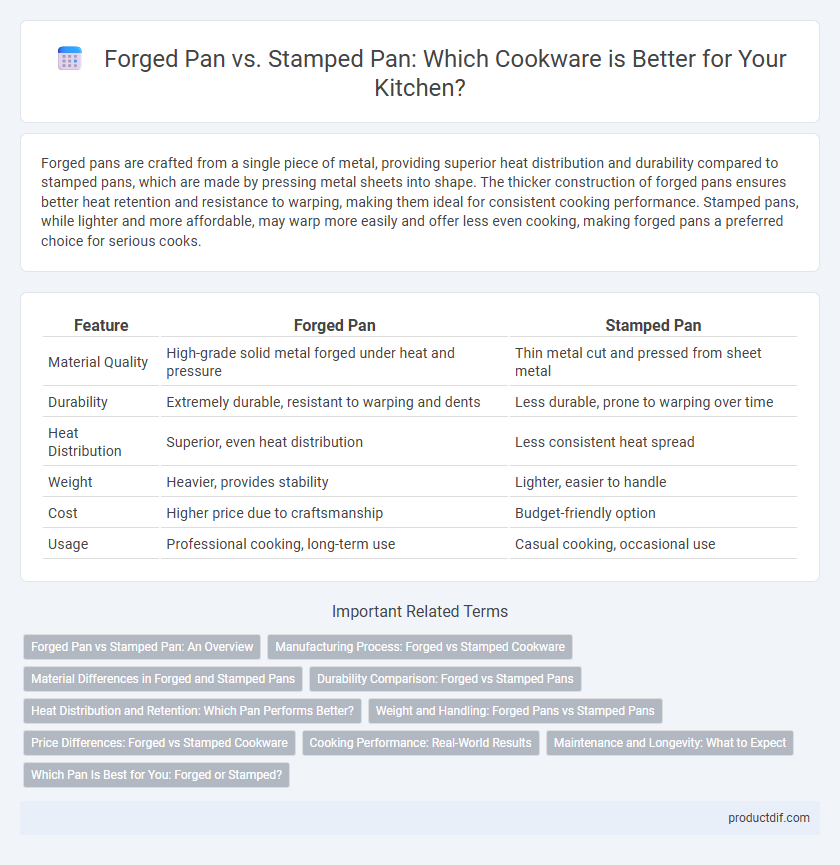Forged pans are crafted from a single piece of metal, providing superior heat distribution and durability compared to stamped pans, which are made by pressing metal sheets into shape. The thicker construction of forged pans ensures better heat retention and resistance to warping, making them ideal for consistent cooking performance. Stamped pans, while lighter and more affordable, may warp more easily and offer less even cooking, making forged pans a preferred choice for serious cooks.
Table of Comparison
| Feature | Forged Pan | Stamped Pan |
|---|---|---|
| Material Quality | High-grade solid metal forged under heat and pressure | Thin metal cut and pressed from sheet metal |
| Durability | Extremely durable, resistant to warping and dents | Less durable, prone to warping over time |
| Heat Distribution | Superior, even heat distribution | Less consistent heat spread |
| Weight | Heavier, provides stability | Lighter, easier to handle |
| Cost | Higher price due to craftsmanship | Budget-friendly option |
| Usage | Professional cooking, long-term use | Casual cooking, occasional use |
Forged Pan vs Stamped Pan: An Overview
Forged pans are crafted from a single piece of metal, offering superior durability and excellent heat retention compared to stamped pans, which are made by pressing metal sheets into shape. The forging process yields thicker, heavier cookware that provides even cooking and enhanced resistance to warping. Stamped pans tend to be lighter and more affordable but generally lack the strength and longevity of forged pans.
Manufacturing Process: Forged vs Stamped Cookware
Forged cookware is made by heating solid metal blocks and shaping them under intense pressure, resulting in a dense and durable structure with excellent heat retention. Stamped cookware is produced by cutting and pressing thin metal sheets into shape, leading to lighter pans with thinner walls that heat quickly but may warp over time. The manufacturing process of forged versus stamped pans significantly affects their longevity, heat distribution, and overall cooking performance.
Material Differences in Forged and Stamped Pans
Forged pans are made from a single piece of metal that is heated and shaped under high pressure, resulting in a thicker, denser material that offers superior heat retention and durability. Stamped pans are produced by pressing thin sheets of metal into shape, creating a lighter and less robust structure with uneven heat distribution. The material density and manufacturing process directly impact the pan's performance, with forged pans typically constructed from high-quality cast aluminum or stainless steel, while stamped pans often use thinner, lower-grade metals.
Durability Comparison: Forged vs Stamped Pans
Forged pans exhibit superior durability due to their thicker, denser metal construction achieved through heavy pressure pressing, making them resistant to warping and long-lasting under high heat. Stamped pans, created by cutting and shaping thinner metal sheets, tend to be lighter but less durable, often warping or bending with frequent use or exposure to intense heat. The enhanced structural integrity of forged pans makes them a preferred choice for professional chefs and serious home cooks seeking cookware longevity.
Heat Distribution and Retention: Which Pan Performs Better?
Forged pans offer superior heat distribution and retention due to their thicker, denser construction, allowing even cooking and minimal hot spots. Stamped pans, being thinner and lighter, heat up quickly but often suffer from uneven heat distribution and faster heat loss. For consistent cooking performance and temperature control, forged pans outperform stamped pans significantly.
Weight and Handling: Forged Pans vs Stamped Pans
Forged pans are made from a solid piece of metal, resulting in heavier cookware that offers superior durability and excellent heat retention, making them ideal for precise cooking control. Stamped pans are lighter due to their thinner construction, providing easier handling and faster heating but often sacrificing long-term sturdiness. Choosing between forged and stamped pans depends on the balance between weight preference and desired cooking performance.
Price Differences: Forged vs Stamped Cookware
Forged pans typically have higher price points than stamped pans due to their manufacturing process involving solid metal blocks, which enhances durability and heat distribution. Stamped cookware, made from thinner sheets of metal pressed into shape, offers budget-friendly options but may sacrifice longevity and even heating. Consumers often balance cost against performance, with forged pans favored for investment in long-term cooking efficiency.
Cooking Performance: Real-World Results
Forged pans offer superior heat retention and even distribution due to their dense, solid construction, which enhances cooking performance by preventing hotspots and promoting consistent browning. Stamped pans, while lighter and more affordable, often heat unevenly and cool quickly, leading to inconsistent cooking results. For professional or frequent home cooks seeking precise temperature control and durability, forged pans deliver significantly better real-world performance.
Maintenance and Longevity: What to Expect
Forged pans, crafted from a single piece of metal, offer superior durability and resistance to warping, making them easier to maintain over time with proper seasoning and cleaning. Stamped pans, made from thinner metal sheets, tend to wear out faster and are more prone to dents and warping, requiring gentler care to extend their lifespan. Investing in forged cookware ensures longer usability and consistent performance, while stamped pans may need replacement sooner due to their lower structural integrity.
Which Pan Is Best for You: Forged or Stamped?
Forged pans offer superior durability and heat retention due to their thicker construction, making them ideal for serious home cooks seeking long-lasting performance. Stamped pans are lighter and more affordable, perfect for casual users who prioritize ease of handling and quick heating. Choosing between forged and stamped pans depends on your cooking style, budget, and preference for weight versus sturdiness in cookware.
Forged Pan vs Stamped Pan Infographic

 productdif.com
productdif.com